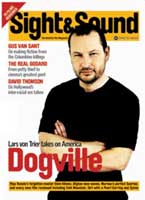
The Homecoming
Film of the Month: Cold Mountain

Anthony Minghella's Cold Mountain, set during the American Civil War, chimes unexpectedly with the current climate, says Edward Buscombe.
When Charles Frazier wrote his award-winning novel Cold Mountain , published in 1997, he could scarcely have foreseen the resonance, six years later, of setting his story during a war launched amid widespread controversy and self-righteousness, with much boasting about how it would be over in a month, only for the conflict to drag on. The novel takes place during the American Civil War and follows the long journey that Inman (here played by Jude Law), a deserter from the Confederate army, makes back to his home town of Cold Mountain, where his sweetheart Ada (in the film Nicole Kidman) - whose struggle to survive there forms the second strand of the tale - is waiting for him. The specific politics of the American Civil War are not ignored, either in the book or in Anthony Minghella's film adaptation: there are revealing snatches of conversation with Ada's father (Donald Sutherland) and brief but telling encounters with slaves on the road. But the story has a wider significance than any one war can supply, for Inman's desertion is not a protest against the Southern cause but the result of a profound war-weariness brought to the point of desperation by Ada's frantic plea for him to return home. The chief subject of the book is the brutality and degradation of war itself; even so, a tale whose hero is a deserter may derive some additional piquancy from the present context.
Frazier's is not an easy book to film: there's too much incident and action to be accommodated even in a long movie like this. But one thing that makes the book so distinctive is the meticulous description of the natural world - the country through which Inman travels and the farm that Ada and Ruby, the local woman who helps her, struggle to shape to their needs. Minghella's film, finely photographed by John Seale, with evocative shots of seashore and mountains (Romania doubling for North Carolina), nevertheless reserves its chief energy for character and incident, and so inevitably jettisons something of the original.
The picaresque episodes during Inman's trek, with their gallery of grotesques, are strikingly presented: the feckless preacher he falls in with (a typically quirky comic performance by Philip Seymour Hoffman); the strange old woman (Eileen Atkins) he meets in the woods, cradling her goat lovingly as she slits its throat; the weaselly backwoodsman and his house of sluttish women, who seize on Inman and the preacher like vultures. It's a society on the edge of disintegration, reduced to dog eat dog, even back at Cold Mountain itself, where the bullying and sadistic Teague terrorises the town and feathers his own nest under the guise of hunting down deserters.
Minghella elects to be largely faithful to the novel. His script manages the difficult task of finding a verbal idiom that's neither gratingly contemporary nor self-consciously archaic. Though he's aided here by Frazier's original dialogue, Minghella has lines of his own which are as starkly eloquent as the author's, as when Inman tries to explain to Ada how the war has changed him: "If I had goodness, I lost it."
Even so, there are some changes of emphasis. The film begins with a large-scale reconstruction of a moment in the Battle of Petersburg that's far more elaborate than anything described in the book. It makes for a spectacular opening (if a slightly confusing one; those who are not Civil War buffs might be surprised to learn that Petersburg was a Confederate victory).
A more important alteration relates to Frazier's method. Evidently he tried to write a novel in which the characters' emotions and behaviour are as Victorian as their speech. But this is a potential problem in adapting the story into a film for a mass audience. One consequence appears to be a more explicit treatment of sexuality. Thus when Inman is about to depart for the war and Ada calls on him unexpectedly, she is taken aback to find him naked to the waist (in the book he is wearing a shirt, which is equally shocking). The later scene in which Inman and Ada finally make love is also a good deal more explicit in the film than in the book. Similarly, when Inman and the preacher are taken in by the backwoods family, the film shows the preacher surrounded by several naked women, all intent on taking their pleasure with him. In the book there is no such scene; one of the women does offer herself to Inman but the home guard arrive before he can make up his mind whether to accept.
Later, when Inman goes to the rescue of the poor widow beset by Union soldiers, the film has him save her from a graphic rape (she's spread-eagled on a table), and when Inman looks set to let one of her assailants go, the woman grabs his gun and shoots the soldier in revenge. In the book, though the soldiers threaten the woman's baby, their only interest is food. They leave once they find her pig; but the pig is all that stands between the woman and starvation, and Inman goes after the soldiers, kills them and returns the pig. What is the purpose of this change? Is it that contemporary audiences cannot properly sympathise with the prospect of starvation, and instead require the frisson of sexual violence if they are to experience fully the horrors of war?
By contrast, although the violence of war and its aftermath is by no means glossed over in the film, it is, compared to the sex, rather less explicit. After Inman has killed all three soldiers, Frazier describes how a chicken "has its head immersed in the broken open belly" of one of the men. "It pecked at the colorful flesh pulp of his exploded guts." You can hardly blame Minghella for not showing us this, but it does suggest how squeamish the cinema audience is despite all the talk of how screen violence has deadened our responses.
Minghella is well served by his cast. Both principals are convincing, if neither rises quite to the heights of genuine tragedy. Some felt that the life went out of Minghella's previous film The Talented Mr. Ripley when Jude Law departed the action; this time, fortunately, he is on screen for most of the film, suggesting well the innate reserve and self-sufficiency of the appropriately named Inman, which, cautiously at first, he allows Ada to penetrate. Nicole Kidman finds the right combination of girlishness and inner strength which enables her first to attract Inman but then to survive his departure and confront her hopelessly inadequate preparation for the exigencies of war: "I can embroider, but I can't darn," she cries in exasperation. Only in their accents do they fall short, neither Law nor Kidman giving an impression of much time spent south of the Mason-Dixon line. Of the rest, only Renée Zellweger, ironically one of the few Americans in the film, fails to hit the right note; she has an energetic go at Ruby, but tries over-hard to make her into a 'character' by excessive facial mugging.
